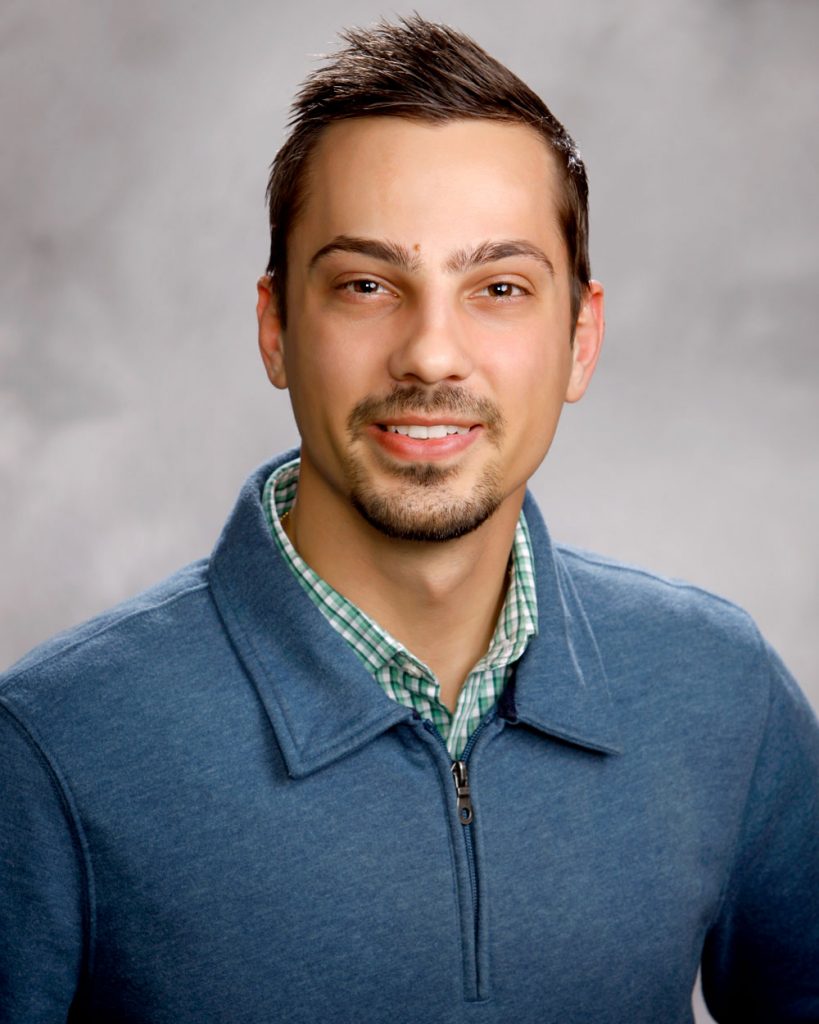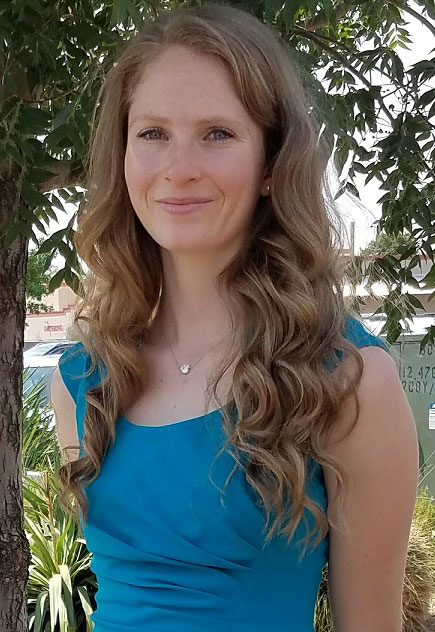Since 2004, Harry S. Truman Fellows in National Security Science and Engineering have come to Sandia each year to pursue high-risk, high-reward ideas that support the Labs’ national security mission.
Sandia recently welcomed 2023 fellows Joseph Cuozzo and Josefine McBrayer, who began their three-year postdoctoral appointments last year.
The fellowship is extended to early-career researchers pursuing independent ground-breaking research and is named for President Truman who saw the possibility for Sandia in 1949 to provide “an exceptional service in the national interest.”
Joseph Cuozzo: Taking high-speed computing forward

Joseph plans to use his fellowship to develop quantum-scale technologies that can evolve high-speed computing to the next level of performance and capability — and he is well on his way to doing so.
“My area of expertise is in describing how electrons behave in very small devices at very low temperatures,” he said. “Some of these devices are only hundreds of atoms thick, roughly a thousandth of the thickness of a single human hair, and operate at temperatures colder than deep space.”
Joseph said most people have experienced how hot a laptop computer can get when running. Electrons are moving around inside the system and as they encounter resistance, they generate heat — like rubbing your hands together on a cold day. He adds that many metals, when cooled to intensely cold temperatures, no longer resist the movement of electrons, a phenomenon called superconductivity.
“Superconductivity is a quantum mechanical effect, and there are many quantum effects we can observe when we study devices at low temperatures and small length scales,” Joseph said. “We can also investigate how quantum properties of different materials interact by stacking them on top of one another, forming a heterostructure. Creating heterostructures allow us to engineer devices with very exotic properties. I’m interested in investigating these exotic properties. For instance, we can design heterostructures to create topological superconductors that can be used as the basis of quantum computers.”
Joseph is investigating if it is possible to craft topological features in a structure that allows superconductivity that becomes the basis for quantum computing. He hopes his work can help reduce errors in quantum calculations.
“By reducing errors, quantum computers have the potential to address problems ranging from ambient-pressure, room-temperature superconductivity — for use in low-power technologies — to chemical and biological processes, such as the reaction mechanism for biological nitrogen fixation in nitrogenase,” he said, explaining the enzymes produced by certain bacteria that are responsible for the reduction of nitrogen to ammonia.
Joseph graduated from the University of South Florida in 2017 with degrees in math and physics and completed his doctorate at the College of William & Mary in 2022, authoring his dissertation, “Electronic transport in topological superconducting heterostructures.” His road to Sandia and to the Truman Fellowship began quite young.
“My father works at a hospital as an MRI safety officer,” he said. “As a child, he would show me his MRI machine, which is more or less a giant magnet, and demonstrate some pretty amazing features of magnetism and what a really powerful magnet can do. Those experiences sparked my curiosity and orientated me towards developing practical technology that can benefit society.”
He chose Sandia for his postdoc work after working as a year-round graduate intern in materials physics.
“I enjoyed the camaraderie with those on my team and the support I received from my mentor Wei Pan while I explored new ideas. The combination of a highly collaborative environment, strong support of cutting-edge research from the Nano Micro LDRD program, and a strong sense of mission at Sandia to support the national interest made my decision to work here an easy one,” he said, recounting that he is most proud of his work on the discovery of a Leggett mode in Dirac semimentals. “I feel extremely honored to be named a Truman Fellow at one of the premier research laboratories in the world. The freedom and resources that the Truman Fellowship offers will bring my vision to fruition and I’m very excited about that.”
Josefine McBrayer: Battery improvements her goal

Josefine has always loved math and science.
“If you don’t remember a name or date, you have to look it up,” she said. “In math, if you don’t remember a solution, you can work it out.”
She always had a passion for school, earning all A’s from first grade in an Albuquerque public school through her doctorate in chemical engineering at the University of Utah. Her stopover at the University of New Mexico for a bachelor’s in chemical engineering and a master’s in nanoscience and microsystems engineering also met with academic success.
Probably as important for Sandia’s Truman Fellowship committee were Josey’s groundbreaking experiments to improve battery lifetimes — a major problem for U.S. industry and defense — and the impressive letters of references that preceded her.
As one letter put it, “… working with Josey on research problems [was] not like working with a student — it [was] much more like working with a professional colleague who possesses excellent judgment and maturity about research directions.”
As a master’s student studying energy storage, she sought to improve the longevity of lithium-sulfur batteries. Promising because of their high energy density, the batteries are typically plagued by intermediate chemicals that, appearing and diffusing, weaken the mix — the so-called “polysulfide shuttle” problem.
Josey developed a spectroscopic technique to track the concentration and location of the various polysulfides in-situ as they changed and diffused through the battery cell during its discharge cycle. Researchers used the chemical transformations her observations revealed to suggest methods to mitigate polysulfides’ formation and transformations. By applying these methods, the cycle life of lithium-sulfur cells, which had been limited to less than 10 recharges, could be extended to almost 10 times that amount.
For her doctoral research, Josey developed techniques to determine how long a lithium-ion battery with a silicon anode maintains a charge while sitting idle. Determining how long a battery will work once it’s off its charger and deployed in the field is critical to national defense. Batteries may be deployed for years before being activated. The usual method is to accelerate the aging process by heating battery components to higher temperatures, which works but also activates chemical interactions that would not necessarily occur in batteries sitting on a shelf.
Josey helped develop a voltage-hold protocol, which provides an early indicator of performance in model silicon anodes in a fraction of the time and without the complicating side effects. These techniques have become the standard within the DOE’s Vehicle Technologies Office Silicon Battery Projects and are being deployed as a best practice in performing shelf-life aging studies on new battery material. Academia and industry also routinely use the techniques when studying battery shelf life.
Josey’s doctoral dissertation aligned her to be the principal investigator of a joint Laboratory Directed Research and Development and Homeland Security project requesting “… modifications to improve performance and safety in rechargeable lithium metal batteries.”
Josey credits much of her success to now-retired senior scientist Chris Apblett and current mentor Katie Harrison. She said Apblett introduced her to electrochemistry as an undergraduate intern at Sandia, and “changed my life by being the first person in my field to respect me as a scientist.” Apblett allowed Josey to design her own projects on lithium-metal batteries and, through these projects, found money to help pay for her master’s. As an officer in the Society of Women Engineers, she helped others succeed in science.
Josey grew up with a family foundation in science: her mother, father, brother and sister all took jobs in technical fields. As a child, she wanted to be a scientist with a doctorate, like her dad.
“I’m never bored building batteries and doing electrochemical testing,” she said. “A growing field — such a broad use, so many different chemistries with a variety of applications.”